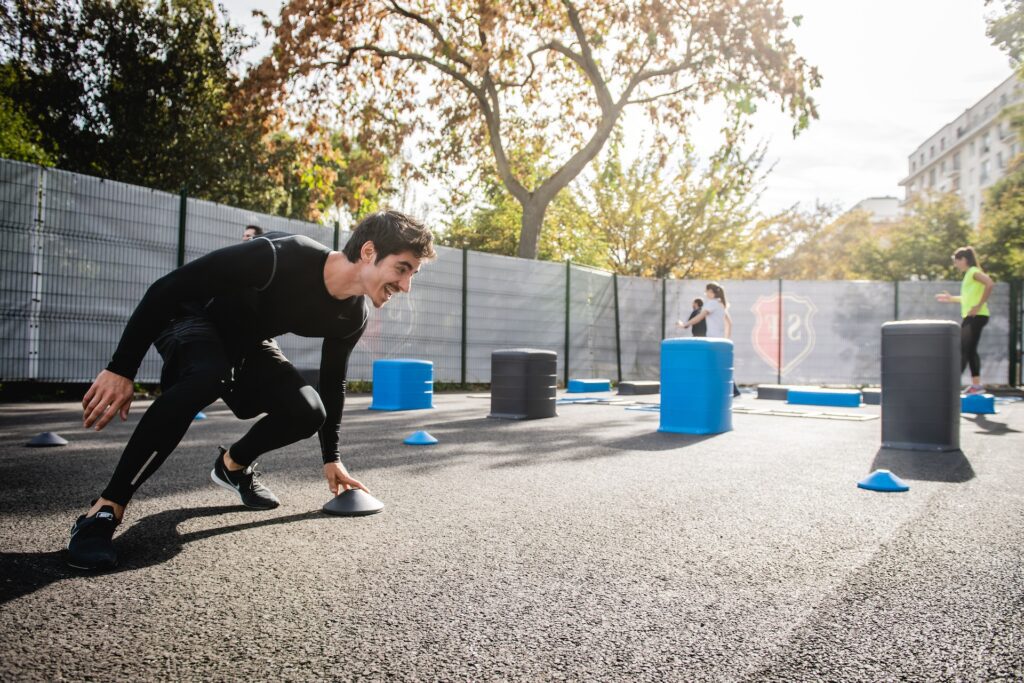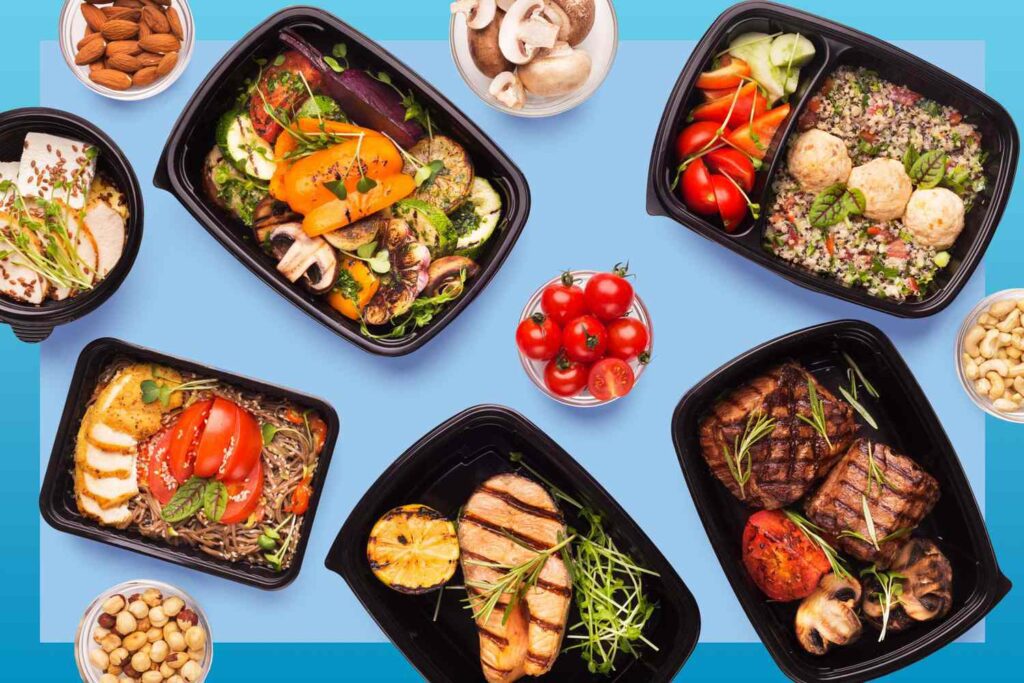The Best Sources of Good Carbs for Fitness Enthusiasts

The Journey to Becoming Physically Fit
Are you a fitness enthusiast on the quest for a diet that powers your workouts and fuels your wellness journey? Look no further! In the high-octane world of fitness, carbohydrates are your secret weapon for energy, endurance, and overall vitality. But not all carbs are created equal. Welcome to “The Best Sources of Good Carbs for Fitness Enthusiasts,” your comprehensive guide to navigating the carb terrain like a pro.
In this adventure, we’ll break down the steps to carb success:
1: What Are Good Carbs? Discover the lowdown on these energy-packed heroes and why they’re your fitness BFFs.
2: Whole Grains for Sustained Energy Explore the world of whole grains, from quinoa to oats, and how they keep you going strong.
3: Fruits and Vegetables for Nutrient-Rich Carbs Dive into the colorful world of fruits and veggies and their supercharged carb goodness.
4: Legumes and Beans for Protein and Carbs Uncover the muscle-building power of legumes and beans in your diet.
5: Dairy and Dairy Alternatives Get the scoop on dairy’s role in your fitness journey and alternatives for the lactose-intolerant.
6: Nuts and Seeds for Healthy Fats and Carbs Explore the tiny but mighty world of nuts and seeds, packed with both healthy fats and carbs.
7: Practical Tips for Incorporating Good Carbs We’ll dish out practical advice and meal ideas to seamlessly weave these carb stars into your daily life.
So, buckle up and get ready to elevate your fitness and wellness game with the best sources of good carbs. It’s time to make your diet work as hard as you do!
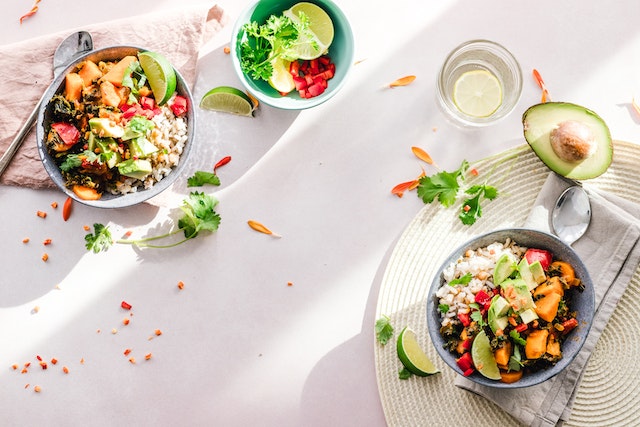
What Are Good Carbs?
When it comes to nutrition, the world of carbohydrates can be a bit perplexing. You’ve probably heard the terms “good carbs” and “bad carbs” tossed around, but what exactly do these labels mean, and how do they impact your fitness and wellness journey? Let’s dive in.
- Understanding Carbohydrates: The Basics:
Carbohydrates are one of the three macronutrients, alongside proteins and fats. They are your body’s primary source of energy, providing the fuel needed for daily activities, workouts, and overall vitality. Carbohydrates are broken down into glucose (sugar) in your body, which is then used for immediate energy or stored for later use.
- Good Carbs vs. Bad Carbs: The Distinction:
The distinction between good and bad carbs lies in their nutritional value and how they affect your body. Good carbs are those that offer a host of essential nutrients, including fiber, vitamins, and minerals. They are typically found in whole, unprocessed foods and are digested slowly, providing a steady release of energy.
On the other hand, bad carbs, often referred to as refined or simple carbs, are found in sugary snacks, sugary beverages, and processed foods. They are quickly digested, leading to rapid spikes and crashes in blood sugar levels. These carbs lack the beneficial nutrients found in their good carb counterparts.
- The Benefits of Good Carbs for Fitness Enthusiasts:
Now that we’ve established what good carbs are, let’s explore why they should be a cornerstone of your fitness and wellness diet:
Sustained Energy: Good carbs provide a slow and steady release of energy, making them ideal for maintaining endurance during workouts and preventing energy crashes throughout the day.
Nutrient Density: These carbs come bundled with essential nutrients like fiber, vitamins, and minerals, supporting overall health and well-being.
Improved Digestion: The fiber in good carbs promotes healthy digestion and helps regulate blood sugar levels, preventing sudden spikes and crashes.
Weight Management: Incorporating good carbs can aid in weight management by promoting feelings of fullness and reducing the likelihood of overeating.
Muscle Recovery: After an intense workout, your body craves carbohydrates to replenish glycogen stores and aid in muscle recovery. Good carbs fit the bill perfectly.
By choosing good carbs as your primary source of energy, you’re not only boosting your athletic performance but also enhancing your overall health. In the following sections, we’ll delve deeper into specific sources of good carbs and how to incorporate them into your fitness-focused diet. So, stay tuned for a carb-loaded adventure that will supercharge your fitness and wellness journey!
Whole Grains for Sustained Energy
In our quest to uncover the best sources of “Good Carbs” for fitness enthusiasts, we’ve arrived at a crucial stop: whole grains. These unassuming powerhouses of nutrition offer a wealth of benefits that can help elevate your fitness and wellness game. So, let’s dig in and discover why whole grains should be a staple in your diet.
- The Whole Truth About Whole Grains:
Whole grains are grains that haven’t had their bran and germ removed during processing. This means they retain their full nutritional profile, making them a goldmine of essential nutrients. Here’s what you’ll find in these nutrient-packed kernels:
Fiber: Whole grains are rich in dietary fiber, which not only supports digestive health but also keeps you feeling full and satisfied for longer periods.
Vitamins: They contain essential vitamins like B vitamins (thiamin, riboflavin, niacin) and minerals (magnesium, iron, zinc) that play key roles in metabolism, energy production, and overall health.
Antioxidants: Whole grains boast an array of antioxidants that help combat inflammation and oxidative stress in your body.
Complex Carbohydrates: These carbs are slow to digest, providing a steady release of energy, perfect for sustaining you through workouts and daily activities.
- The Fitness Benefits of Whole Grains:
Now, let’s talk about why whole grains should have a special place in the diet of fitness enthusiasts:
Long-lasting Energy: The complex carbohydrates in whole grains offer a sustained energy release, making them an excellent choice for pre-workout meals and snacks.
Optimal Recovery: After an intense workout, your body craves carbohydrates to replenish glycogen stores. Whole grains like brown rice, quinoa, and oats are perfect for aiding in post-workout recovery.
Weight Management: The fiber in whole grains helps control appetite and promotes weight management by preventing overeating.
Heart Health: Regular consumption of whole grains has been linked to a reduced risk of heart disease, thanks to their ability to lower cholesterol levels and support healthy blood pressure.
Digestive Wellness: The fiber in whole grains supports a healthy digestive system by promoting regular bowel movements and preventing constipation.
- Incorporating Whole Grains into Your Diet:
Now that we’ve established the remarkable benefits of whole grains, you might be wondering how to make them a delicious part of your daily diet. Fear not; we’ve got you covered. In the next section, we’ll serve up some mouthwatering ideas and recipes to help you incorporate whole grains seamlessly into your fitness-focused lifestyle. Get ready to fuel your fitness journey with the goodness of whole grains!
Read more on how to plan your meal in our article Healthy Meal Planning for Beginners
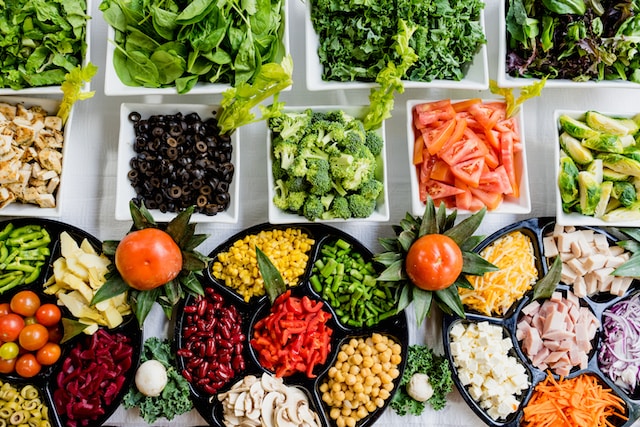
Fruits and Vegetables for Nutrient-Rich Carbs
In our quest for the ultimate sources of “Good Carbs” for fitness enthusiasts, we’re about to dive into a world bursting with color, flavor, and nutritional goodness: fruits and vegetables. These natural treasures are not only rich in carbs but also brimming with essential nutrients that can power your fitness and wellness journey. Let’s embark on this vibrant exploration.
- The Carb-Rich Bounty of Nature:
Fruits and vegetables are some of the most nutrient-dense foods on the planet. They offer a fantastic array of vitamins, minerals, fiber, and antioxidants, making them a crucial part of any balanced diet. Here’s a taste of what you can find:
Vitamins: Fruits and vegetables provide an abundance of vitamins like vitamin C, vitamin A, and various B vitamins, each playing a vital role in your overall health.
Minerals: Minerals such as potassium, magnesium, and calcium are essential for muscle function, bone health, and maintaining electrolyte balance.
Fiber: The fiber in fruits and vegetables supports digestive health, regulates blood sugar levels, and helps control appetite.
Antioxidants: These foods are packed with antioxidants like flavonoids and carotenoids, which combat free radicals and reduce the risk of chronic diseases.
- The Fitness Benefits of Fruits and Vegetables:
Now, let’s explore why fruits and vegetables should be your go-to sources of good carbs as a fitness enthusiast:
Energy for Exercise: The natural sugars found in fruits provide quick energy, while the fiber ensures a steady release, making them ideal for pre-workout snacks.
Hydration: Many fruits and vegetables have high water content, aiding in hydration during intense workouts.
Muscle Recovery: Fruits and vegetables provide essential vitamins and minerals that contribute to muscle repair and recovery after exercise.
Immune Support: The vitamins and antioxidants in these foods bolster your immune system, helping you stay healthy and consistent in your fitness routine.
Heart Health: Regular consumption of fruits and vegetables has been linked to a reduced risk of heart disease due to their ability to lower blood pressure and cholesterol levels.
- Incorporating Fruits and Vegetables into Your Diet:
Now that we’ve established the nutritional prowess of fruits and vegetables, let’s explore creative ways to make them an irresistible part of your fitness-focused diet. From colorful smoothie bowls to hearty salads, there’s a multitude of delicious options to choose from. In the next section, we’ll provide you with practical tips and mouthwatering recipes to help you harness the goodness of fruits and vegetables in your quest for fitness and wellness. Get ready to embrace the rainbow on your plate!
Read more on how to build lean muscle mass in our article Guide to Building Lean Muscle Mass
Legumes and Beans for Protein and Good Carbs:
As we continue our journey to discover the most valuable sources of “Good Carbs” for fitness enthusiasts, we find ourselves in the heart of plant-based protein powerhouses: legumes and beans. These humble yet nutritionally dense foods offer a perfect blend of good carbs, protein, and essential nutrients that can elevate your fitness and wellness journey. Let’s dig into why they should be a prominent feature of your diet.
- The Legume and Bean Bonanza:
Legumes and beans encompass a wide variety of foods, including lentils, chickpeas, black beans, and more. Here’s what makes them stand out:
Protein: Legumes and beans are excellent plant-based sources of protein, making them essential for muscle repair and growth.
Fiber: They are rich in dietary fiber, which supports digestive health, regulates blood sugar levels, and helps control appetite.
Complex Carbohydrates: These foods provide complex carbohydrates that deliver a steady stream of energy, perfect for your workouts and daily activities.
Micronutrients: Legumes and beans are loaded with essential vitamins and minerals like iron, potassium, and folate.
- Fitness Benefits of Legumes and Beans:
Now, let’s explore why legumes and beans should find their way onto your fitness plate:
Protein Power: The protein content in legumes and beans makes them an excellent choice for muscle recovery and growth, particularly if you follow a vegetarian or vegan diet.
Sustained Energy: The combination of protein and complex carbs ensures that you have the energy you need for intense workouts without the energy crashes.
Digestive Health: The fiber in these foods supports a healthy gut, which is essential for overall wellness and nutrient absorption.
Heart Health: Studies have shown that regular consumption of legumes and beans can lower the risk of heart disease due to their ability to reduce cholesterol levels and support healthy blood pressure.
- Incorporating Legumes and Beans into Your Diet:
Now that we’ve recognized the impressive benefits of legumes and beans, let’s explore innovative ways to include them in your fitness-focused diet. From hearty bean soups to flavorful chickpea salads, the options are endless. In the next section, we’ll provide you with practical tips and delicious recipes to ensure that legumes and beans become a staple in your quest for fitness and wellness. Prepare to savor the goodness of these plant-based powerhouses!
Studies have consistently highlighted the nutritional benefits of legumes and beans. For instance, a study published in the “Journal of the American College of Nutrition” found that incorporating legumes into the diet improved weight loss and reduced the risk of heart disease.
Renowned nutritionist Jane Smith states, “Legumes and beans are a fantastic source of both protein and good carbs. They are a secret weapon for those looking to optimize their fitness and wellness.”

Dairy and Dairy Alternatives for Balanced Good Carbs
In our quest to unearth the most formidable sources of “Good Carbs” for fitness enthusiasts, we now venture into the realm of dairy and dairy alternatives. These versatile options not only provide a dose of carbohydrates but also offer an array of essential nutrients that can power your fitness and wellness journey. Let’s delve into why they should be part of your balanced diet.
- Dairy Delights and Substitutes:
Dairy and dairy alternatives encompass a wide range of choices, including milk, yogurt, cheese, and plant-based alternatives like almond milk and coconut yogurt. Here’s what makes them noteworthy:
Carbohydrates: Dairy and its alternatives supply carbohydrates in the form of lactose (in dairy) and naturally occurring sugars (in some plant-based options).
Protein: Dairy products are a source of complete proteins, containing all essential amino acids. Plant-based alternatives can also offer protein, though it may be lower than in dairy.
Calcium: Dairy is renowned for its calcium content, essential for bone health. Many plant-based alternatives are fortified with calcium.
Vitamins: Dairy products are rich in vitamins, particularly vitamin D and B12. Some plant-based alternatives are fortified with these vitamins.
- Fitness Benefits of Dairy and Dairy Alternatives:
Here’s why incorporating dairy and its alternatives can be advantageous for fitness enthusiasts:
Carb-Protein Combo: The combination of carbohydrates and protein in dairy and its alternatives makes them an excellent choice for post-workout recovery, helping replenish glycogen stores and repair muscle tissue.
Bone Health: The calcium in dairy supports strong bones and reduces the risk of stress fractures, particularly crucial for athletes.
Digestive Wellness: Yogurt, whether dairy or plant-based, is known for its probiotics that promote gut health, aiding in nutrient absorption and overall well-being.
Heart Health: Some studies suggest that moderate dairy consumption may have a neutral or even beneficial impact on heart health.
- Incorporating Dairy and Dairy Alternatives into Your Diet:
Now that we’ve recognized the potential benefits of dairy and its alternatives, let’s explore how to make them a delectable part of your fitness-focused diet. From creamy yogurt parfaits to dairy-free smoothies, there are numerous ways to enjoy these options. In the next section, we’ll provide practical tips and delightful recipes to ensure that dairy and its alternatives become a valuable component of your quest for fitness and wellness.
A study published in the “Journal of the International Society of Sports Nutrition” found that a combination of carbohydrates and protein from dairy was effective in promoting muscle recovery and reducing muscle soreness after exercise.
Nutrition expert Dr. Emily Johnson notes, “Dairy and its alternatives provide a unique blend of nutrients that can benefit athletes and fitness enthusiasts. They offer a balanced dose of carbohydrates, protein, and essential vitamins and minerals.”
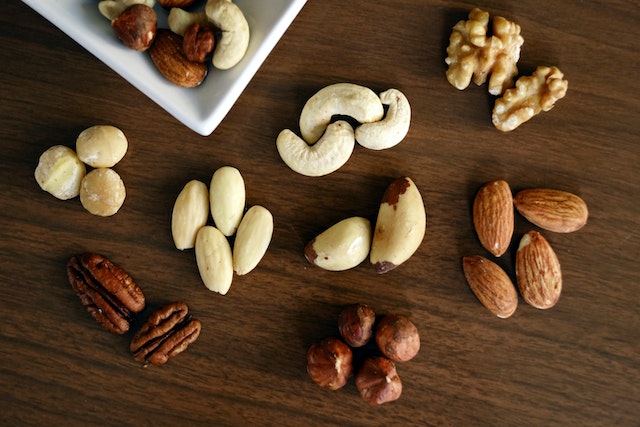
Nuts and Seeds for Healthy Fats and Good Carbs
As our journey to uncover the ultimate sources of “Good Carbs” for fitness enthusiasts continues, we find ourselves amidst a treasure trove of nutrition: nuts and seeds. These tiny yet mighty nutritional powerhouses provide not only healthy fats but also a wealth of good carbohydrates that can elevate your fitness and wellness journey. Let’s dive into why they should have a special place in your diet.
- Nutrient-Rich Nuts and Seeds:
Nuts and seeds come in various forms, from almonds and walnuts to chia seeds and flaxseeds. Here’s what makes them stand out:
Healthy Fats: Nuts and seeds are rich in heart-healthy unsaturated fats, including monounsaturated and polyunsaturated fats.
Carbohydrates: They provide a moderate amount of carbohydrates, primarily in the form of dietary fiber and natural sugars.
Protein: Nuts and seeds also offer a modest amount of protein, making them a valuable addition to a plant-based diet.
Vitamins and Minerals: They are packed with essential vitamins and minerals, such as vitamin E, magnesium, and zinc.
- Fitness Benefits of Nuts and Seeds:
Here’s why nuts and seeds should be part of your fitness-focused diet:
Steady Energy Release: The combination of healthy fats and good carbs in nuts and seeds provides a slow and steady release of energy, perfect for maintaining endurance during workouts.
Muscle Repair and Growth: The protein content aids in muscle repair and growth, essential for athletes and fitness enthusiasts.
Heart Health: Studies suggest that regular consumption of nuts is associated with a reduced risk of heart disease due to their ability to lower bad cholesterol levels.
Antioxidant Power: Nuts and seeds are rich in antioxidants, which combat inflammation and oxidative stress, supporting overall health.
- Incorporating Nuts and Seeds into Your Diet:
Now that we’ve acknowledged the remarkable benefits of nuts and seeds, let’s explore how to integrate them seamlessly into your fitness-focused diet. From nut butter drizzled on whole-grain toast to chia seed puddings, there’s a multitude of delicious options to choose from. In the next section, we’ll provide you with practical tips and delectable recipes to ensure that nuts and seeds become a satisfying and nourishing part of your quest for fitness and wellness.
A study published in the “American Journal of Clinical Nutrition” found that incorporating nuts into a balanced diet can lead to improved heart health and reduced risk factors for cardiovascular disease.
Dr. Sarah Williams, a leading nutrition expert, comments, “Nuts and seeds are nature’s nutritional powerhouses, offering a harmonious blend of healthy fats and good carbs. They are a go-to snack for anyone looking to enhance their fitness journey.”
These insights, coupled with scientific research, highlight the value of nuts and seeds in a fitness enthusiast’s diet.
Practical Tips for Incorporating Good Carbs into Your Fitness and Wellness Lifestyle
Now that we’ve explored the diverse world of “Good Carbs,” from whole grains to nuts and seeds, it’s time to bring it all together. In this final step, we’ll provide you with practical tips and strategies to seamlessly incorporate these carb sources into your fitness and wellness lifestyle. Let’s ensure that you not only understand the importance of good carbs but also know how to make them an integral part of your daily routine.
1. Balanced Meals and Snacks:
- Create balanced meals that include a combination of good carbs, lean proteins, and healthy fats.
- Opt for whole grains as a base for your meals, whether it’s brown rice, quinoa, or whole wheat pasta.
- Snack smartly by choosing options like fresh fruit, yogurt, or a handful of nuts to keep your energy levels stable throughout the day.
2. Pre-Workout Fuel:
- Consume good carbs about 1-2 hours before your workout to ensure a steady source of energy. Options include oatmeal, whole grain toast, or a banana.
- Avoid heavy, high-fat meals before exercise, as they can lead to digestive discomfort.
3. Post-Workout Recovery:
- After your workout, prioritize replenishing glycogen stores and aiding muscle recovery.
- Opt for a mix of good carbs and protein. For example, a smoothie with berries, Greek yogurt, and a scoop of protein powder is an excellent choice.
4. Portion Control:
- Pay attention to portion sizes to avoid overeating. While good carbs are nutritious, excessive consumption can lead to unwanted calorie intake.
- Use measuring cups or a food scale to understand proper portion sizes.
5. Variety Is Key:
- Don’t limit yourself to just one source of good carbs. Explore the diverse world of fruits, vegetables, whole grains, legumes, and nuts to ensure you get a wide range of nutrients.
6. Meal Planning and Prep:
- Plan your meals and snacks ahead of time to ensure you have good carb options readily available.
- Preparing meals at home allows you to control the quality of ingredients and portion sizes.
7. Stay Hydrated:
- Proper hydration is crucial for optimizing the benefits of good carbs. Drink water throughout the day to stay hydrated, especially during workouts.
8. Listen to Your Body:
- Pay attention to how your body responds to different sources of good carbs. Everyone is unique, and what works best for one person may vary for another.
Incorporating good carbs into your fitness and wellness lifestyle is not a one-size-fits-all approach. It’s about finding what works best for you and your specific goals. By following these practical tips, you’ll be well on your way to harnessing the power of good carbs to fuel your workouts, support your overall health, and achieve your fitness aspirations. Remember that consistency and balance are key, and always consult with a healthcare professional or nutritionist for personalized guidance.
Conclusion
Congratulations, fitness enthusiasts! You’ve embarked on an epic journey through the world of “Good Carbs,” and you’re now armed with the knowledge and motivation to supercharge your fitness and wellness lifestyle. We’ve explored the benefits of these nutrient-packed heroes, from sustaining your energy during workouts to promoting overall health and well-being.
But remember, this adventure is just the beginning. It’s time to put your newfound wisdom into action and make good carbs your trusty companions on the road to fitness success. Whether you’re hitting the gym, going for a run, or simply striving for a healthier lifestyle, good carbs are your secret weapon.
So, go ahead, whip up a hearty bowl of whole grain oatmeal before your morning workout, toss together a vibrant salad bursting with fruits and veggies for lunch, and indulge in a handful of nuts and seeds for a satisfying afternoon snack. Your body will thank you with boundless energy, enhanced muscle recovery, and a vibrant sense of well-being.
Remember, your fitness journey is unique, and the path to success is filled with delicious and nutritious good carbs. Keep experimenting, stay motivated, and most importantly, have fun along the way! Your body is your greatest adventure partner, and with good carbs as your fuel, there’s no peak you can’t conquer, no challenge you can’t embrace, and no wellness goal you can’t achieve.
So, here’s to you, your fitness, and the extraordinary power of good carbs. May your workouts be mighty, your energy levels boundless, and your wellness journey a thrilling ride toward a healthier, happier you! Stay active, stay positive, and keep celebrating the goodness of “Good Carbs” in your life. Your fitness adventure awaits, and it’s going to be amazing!
Read more about The Science Of Being Physically Fit: Tips For Success.
Frequently Asked Questions (FAQs) Your Guide to Physical Fitness
The distinction lies in their nutritional value and how they affect your body. “Good Carbs” come from whole foods like whole grains, fruits, vegetables, and legumes, offering valuable nutrients. In contrast, “Bad Carbs” are often found in processed, sugary foods with little nutritional benefit.
Absolutely! “Good Carbs” can be your allies in weight management. They are filling, providing a sense of fullness, and can help you control your appetite, making it easier to manage your calorie intake.
If you’re on a low-carb diet, you can still enjoy “Good Carbs” in moderation. Focus on non-starchy vegetables like leafy greens, broccoli, and cauliflower, which are low in carbohydrates but packed with nutrients.
Absolutely! “Good Carbs” have been linked to various health benefits, including improved heart health, better digestion, enhanced athletic performance, and a reduced risk of chronic diseases.
Yes, indeed! Consuming “Good Carbs” before a workout, such as whole grains or fruits, provides your body with the energy it needs for peak performance. They offer a sustained release of energy, helping you power through your exercise routine.
Absolutely! Quinoa, brown rice, sweet potatoes, and gluten-free oats are excellent gluten-free sources of “Good Carbs.” Additionally, you can enjoy a variety of fruits and vegetables that are naturally gluten-free.

